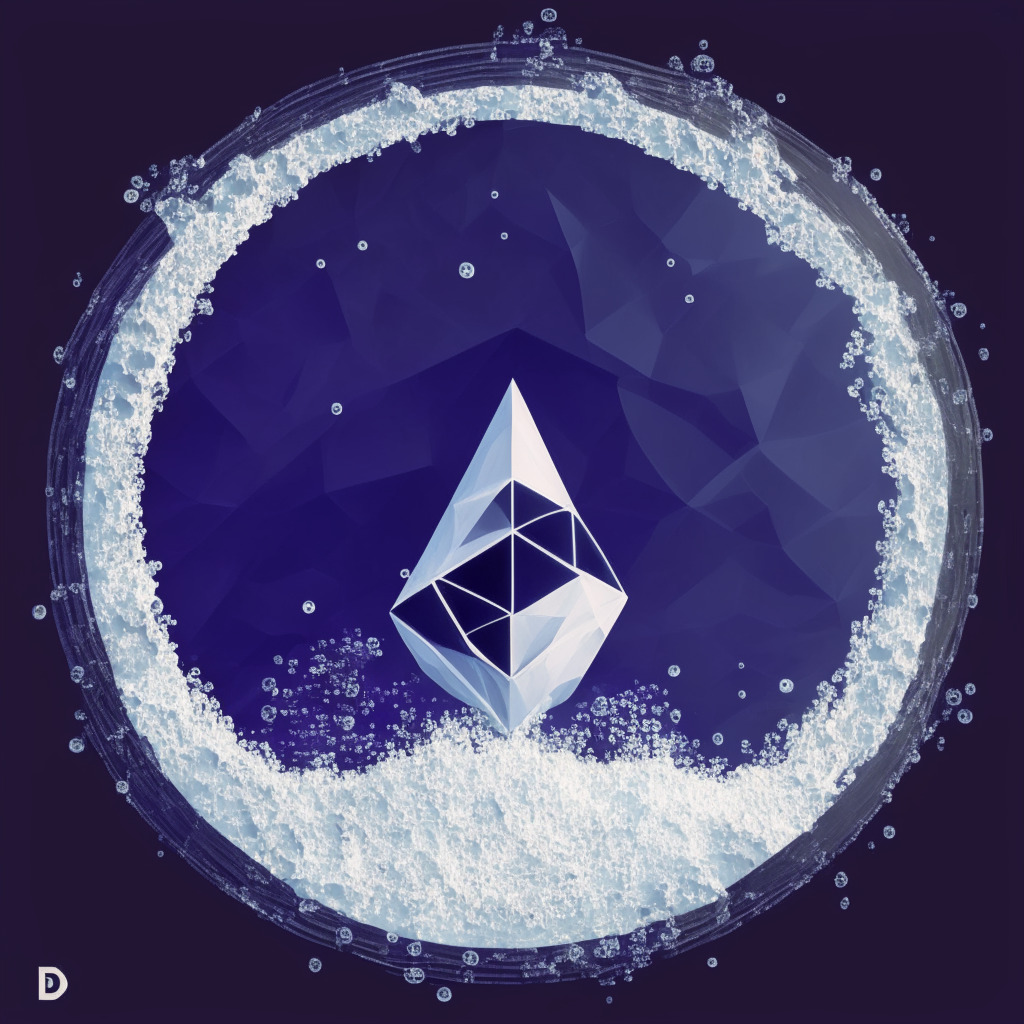Circle, the blockchain and finance tech firm, has revealed its native USDC tokens on the Ethereum Layer 2 scaling protocol, Polygon. This move aims to allow smoother accessibility of USDC to users and developers. Businesses using USDC on Polygon can create decentralized applications for near-instant, low-cost transactions, revolutionizing payments, remittances and trading. However, adoption faces challenges including complex technology and security concerns.
Search Results for: usdc
Xion Unveils Cutting-Edge Layer-1 Blockchain Protocol with Strategic Focus on USDC as Transaction Currency
“CircleBurnt, backed by Animoca and Multicoin, introduces Xion, a novel layer-1 blockchain protocol using USDC, a fiat-backed stablecoin as its primary transaction currency. Xion is designed to simplify web3 complexities, offering tools that require less technical expertise, with the aim of stimulating interaction within the web3 ecosystem.”
Rollercoaster Crypto Market: The Rise of USDC over XRP Amidst Turmoil
“The world’s second-largest US dollar-pegged stablecoin, USD Coin (USDC), recently surpassed the total market capitalization of XRP, a digital token powering the decentralized XRP Ledger, triggering interesting market dynamics. Amidst XRP’s continuous struggle amidst lawsuits and downturns, alternative coins backed by significant influencers, such as $WSM, offer promising diversification prospects.”
Revolutionizing Crypto Transactions: Can USDC be the Ultimate Gas Token on Any Blockchain?
Qredo, a crypto safekeeping firm, has partnered to allow its non-custodial wallet to integrate the popular USDC stablecoin. This could simplify the gas fee equation by transforming USDC into the gas token on any blockchain, influencing how crypto enthusiasts perceive USDC in the decentralized applications and protocols sphere.
Stablecoin De-Pegging: A Deep-Dive into USDC and DAI Performance versus USDT and BUSD
“Analysts reveal ‘de-pegging’ is more common in stablecoins USDC and DAI compared to Tether and Binance USD. While stability ideally requires good governance, collateral and reserves, market confidence and adoption, USDT has shown steadiness despite mainstream scrutiny.”
The Dawn of Gasless USDC Transactions: OKX and Circle Internet Financial’s Game-Changing Launch
“OKX and Circle Internet Financial have launched USDC features on OKX Wallet and the OKX DEX aggregator, enabling gasless USDC transactions and abolishing network fees for cross-chain exchanges. This advancement denotes a significant stride towards easy-to-use, permissionless on-chain utility. The move also signifies stablecoins’ growing influence in the fiscal ecosystem.”
Crossing Bridges: USDC Expansion to Base & Optimism Networks – A Milestone or Misstep?
In a significant development, USD Coin (USDC) has expanded to Base and Optimism networks, allowing Coinbase and Circle account holders to directly transfer their USDC stablecoin to Base. However, the new native USDC struggles with full integration across networks, causing user confusion and scepticism. The future of this decentralized currency hinges on balancing innovation, competition, and user convenience.
VISA Leverages Solana Blockchain and USDC Stablecoin for Faster International Payments
“VISA has enhanced its stablecoin settlement ability with Circle’s USDC stablecoin on the high-speed Solana blockchain, making it one of the first financial institutions to harness Solana for scaled settlements. VISA’s integration of stablecoins like USDC on global blockchain networks aims to improve international settlements speed and give clients a modern option to conveniently transact funds.”
Circle’s Stablecoin USDC Set to Launch on the Base Network: A Leap Forward or a Leap of Faith?
Circle’s CEO Jeremy Allaire recently announced a significant shift for the company’s U.S. dollar-pegged stablecoin, USDC, which will now launch natively on the Base network. This aims to gradually reduce the need for a bridged coin backed by the Ethereum variant. Despite the development, underlying trust issues remain, emphasising the stability of the Base network and potential issues resulting from reliance on bridged tokens.
Coinbase’s Curveball: Acquiring Stake in Circle and Impact on USDC, Coupled With Emerging Legal Battles and Friend.tech’s Surprising Growth
Cryptocurrency exchange Coinbase acquired a minority stake in Circle Internet Financial, causing the dissolution of their Centre Consortium venture, responsible for issuing USD Coin (USDC). Despite this, Circle plans to continue in-house issuance and governance of USDC, which is expanding its support network to include six additional blockchains. Notably, no cash was involved in the transaction between Coinbase and Circle.
Surge in Overseas Adoption of USDC Stirs Global Digital Monetary Revolution
Jeremy Allaire, Circle’s front-man, revealed that 70% of USD Coin (USDC) adoption comes from overseas, dispelling the belief that USDC is favoured primarily within the US. USDC supply has shrunk due to decreased demand and redemptions, but its importance in evolving global digital commerce is evident.
The Bahamas to Disrupt Traditional Cross-Border Payments with USDC-Backed Wallet
“Island Pay, a Bahamian fintech firm, launches a digital wallet named CiNKO, leveraging the USDC stablecoin for financial inclusion. Unlike volatile cryptocurrencies, USDC provides stability, thereby reducing costs in cross-border transactions and greatly aiding the remittance landscape in Latin America.”
SAP Tests USDC Stablecoin Payments: Examining Blockchain’s Impact on Cross-Border Transactions
SAP is testing cross-border stablecoin payments using USDC on Ethereum’s Goerli testnet, aiming to improve international financial transactions. Their blockchain-based solution may offer a more efficient, transparent and cost-effective alternative to traditional cross-border payments, eliminating intermediaries and reducing fees.
SAP Tests USDC for Cross-Border Payments: A Glimpse into Blockchain’s Future in Finance
German software giant SAP plans to utilize the US Dollar Coin (USDC) for testing cross-border payments, aiming to resolve complications faced by SMEs. If successful, this could lead to increased Ethereum-based cryptocurrency adoption and highlight the potential of decentralized finance (DeFi) in the payments industry.
Stablecoin Stability: MakerDAO’s Shift to Spark Protocol and Lessons from the USDC Depreciation
MakerDAO is switching to the Spark Protocol to improve DeFi liquidity and stablecoin resilience after the recent USDC depeg. Through direct deposits on automated market makers, the protocol offers better rates and aims to enhance MakerDAO’s stability mechanisms and functionality across various layer-2 protocols.
USDC Integration into Arbitrum: Exciting Possibilities and Potential Challenges
The integration of Circle Internet Financial’s stablecoin USDC into Arbitrum, a leading layer 2 scaling solution for Ethereum, offers intriguing possibilities for businesses and the crypto community. However, potential challenges posed by software bugs and token price fluctuations should be considered before embracing this rapidly-evolving blockchain innovation.
Stablecoins in a Shifting Regulatory Landscape: USDC’s Potential Advantage Over Rivals
Amidst the recent U.S. regional banking crisis, Circle, the company behind stablecoin USDC, anticipates a more optimistic future. As U.S. lawmakers draft proposals for clear crypto market regulations, Circle’s CEO believes compliance will give USDC a competitive edge over rivals.
Circle’s USDC Stablecoin Launch on Arbitrum: Impacts and Prospects for Blockchain Growth
Circle, a US-based payments firm issuing the USD Coin (USDC) stablecoin, is set to launch its coin natively on Arbitrum, an Ethereum scaling solution, on June 8th. This will provide benefits like maintaining a 1:1 exchange ratio with the US dollar, offering institutional on/off ramps, and supporting the forthcoming Cross-Chain Transfer Protocol (CCTP), which aims to eliminate bridge withdrawal delays.
USDC’s Move to Arbitrum: Boosting Speed and Reviving Stablecoin’s Future
Circle plans to launch a new native version of USDC on the Arbitrum network, aiming to enhance transaction speed using cross-chain transfer protocols. Amid a changing landscape for stablecoins, this move could help regain market share and adapt to the evolving world of blockchain and cryptocurrencies.
Circle’s USDC Expansion: Revolutionizing Layer 2 Ecosystem or Spreading Resources Thin?
Crypto giant Circle is launching its USDC stablecoin on the Arbitrum Layer 2 network, bringing benefits such as eliminating bridge withdrawal delays and enabling upgradeable smart contracts. This introduction aims to revolutionize the Layer 2 ecosystem by improving liquidity and enabling quicker cross-chain transfers. Native USDC launch is scheduled for June 8.
Circle Ditches US Treasury Bonds for USDC: A Wise Move amid Debt Ceiling Showdown?
In response to potential market turbulence due to the U.S. debt ceiling showdown, Circle Internet Financial has divested from U.S. Treasury bonds, backing its USD Coin (USDC) with overnight repurchase agreements instead. This strategic move aims to protect the USDC stablecoin from potential bond market disruptions as lawmakers scramble to avoid a government default. The effectiveness of this strategy remains uncertain.
DAI’s Shifting Collateral Mix: Decreased USDC Backing and Future Decentralization Prospects
MakerDAO’s DAI stablecoin has reduced its USDC backing from 50% to 23.6%, increasing diversification in its backing assets. As dependency on USDC decreases, DAI’s backing now includes more significant real-world assets, such as U.S. government bonds and stablecoins like GUSD and USDP.
Stablecoin Market Shifts: USDT Reigns Supreme as USDC Fumbles with Regulation
The market dominance of stablecoins has shifted, with Tether’s USDT hitting an all-time high and Circle’s USDC experiencing a downturn. Increased transparency is emphasized for stablecoin reserves, while Tether and Circle reduce banking exposure amid economic uncertainty and increase US Treasury holdings.
Stargate’s Response to Fantom’s anyUSDC Crisis: A Lesson in Crypto Adaptability and Resilience
Stargate, the LayerZero cross-chain bridge protocol, unveils a proposal to mitigate risks and protect its ecosystem integrity amid concerns over Fantom’s primary USDC asset, anyUSDC, and recent events affecting Multichain. The plan highlights the importance of adaptability and resilience in the evolving crypto industry.
US Debt Default and Stablecoins: How Circle Aims to Protect USDC Reserves with Repo Agreements
Circle Internet Financial is adjusting the reserves behind the $30 billion USD Coin, considering the possibility of a U.S. government debt default. BlackRock manages the Circle Reserve Fund, now incorporating $8.7 billion in overnight repo agreements as extra protection for the USDC reserve.
US Losing Stablecoin Dominance: USDC’s Struggle and the Rise of Tether Threatens Digital Economy
The US may be losing ground in the digital economy as USD Coin (USDC) faces strong competition from Tether (USDT). This shift could undermine US control and expose the Web3 community to less-regulated forces. Policymakers must prioritize Web3 and stablecoins to ensure America’s influence in the digital economy.
Cryptocurrencies in Conflict Resolve: Israeli Cyberspace Crackdown vs. Crypto Aid Israel
The Israeli police cyber unit and Binance tackled Hamas’ attempts to raise funds via cryptocurrency while Crypto Aid Israel, supported by Fireblocks, was established to receive cryptocurrency donations for displaced citizens securely. The growing cooperation could potentially link cryptocurrency assets and traditional banking, crystalizing a hybrid financial future vision.
Unraveling the Complex Quest for Australia’s Digital Currency: CBDC Exploration and Challenges
The US-based Atlantic Council think tank reported that over half of 130 countries are piloting or launching central bank-issued digital currencies (CBDCs). However, Australia’s journey toward an Aussie digital currency (eAUD) faces complexities, including legal, regulatory, and operational challenges, despite progress made by Blockchain firm Canvas.
Hong Kong’s Regulatory Dilemma: The Price of Protecting Crypto Investors
“Hong Kong is taking steps towards limiting retail stablecoin trading among individual investors due to increasing crypto adoption. Stablecoins’ value is pegged to fiat currencies, providing some stability against crypto turbulence. However, the recent TerraUSD stablecoin collapse underscores the need for stringent regulation to ensure investor protection and maintain price stability.”
Balancing Act: Supervising AI Vs. Regulating Cryptocurrencies – Who Gets the Upper Hand?
This article discusses a project launched by UNESCO and the Dutch government to study AI supervision across Europe, aiming to develop guidelines from best practices. It also highlights the contrast of some nations focusing heavily on AI regulations, while cryptocurrency protocols, such as for stablecoin transactions, are being neglected. The importance is stressed of striking a balance between embracing technological advances and ensuring proper regulation for consumer protection.
PayPal’s PYUSD Stablecoin: Welcomed Asset or Threat to Tether’s Predominance?
Tether co-founder, William Quigley, in a recent interview expressed skepticism towards the acceptance of PayPal’s impending stablecoin. Highlighting that cryptocurrencies earn credibility over time, he outlined that new entrant, PayPal, would face challenges in gaining trust and performance reputation among crypto users. He flagged significant regulatory challenges and the high cost of compliance as potential hurdles for PayPal’s stablecoin.
Bridging Traditional and Digital Finance: Visa’s Pivotal Role and the Future of Crypto Adoption
Visa’s Innovation & Design VP, Akshay Chopra, emphasized the growing role of crypto cards in market activity and everyday transactions in 2021, bridging traditional finance with digital currencies. Recognizing limitations of current financial systems, he proposed blockchain-based alternatives and praised regulatory foresight in places like UAE for embracing crypto-based payments.































